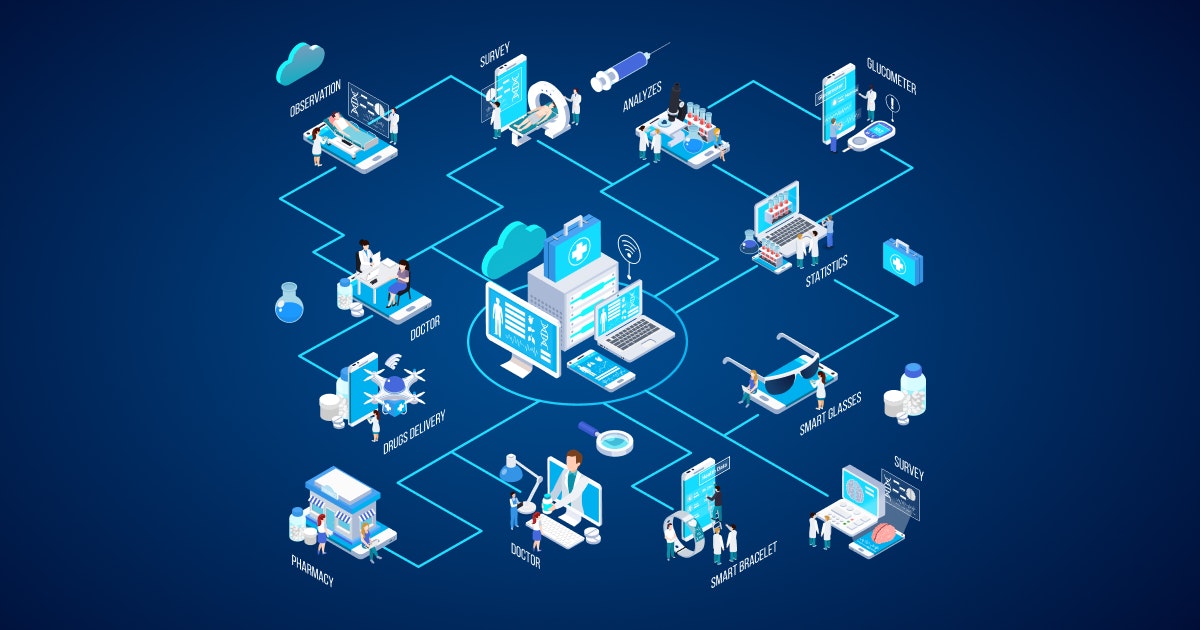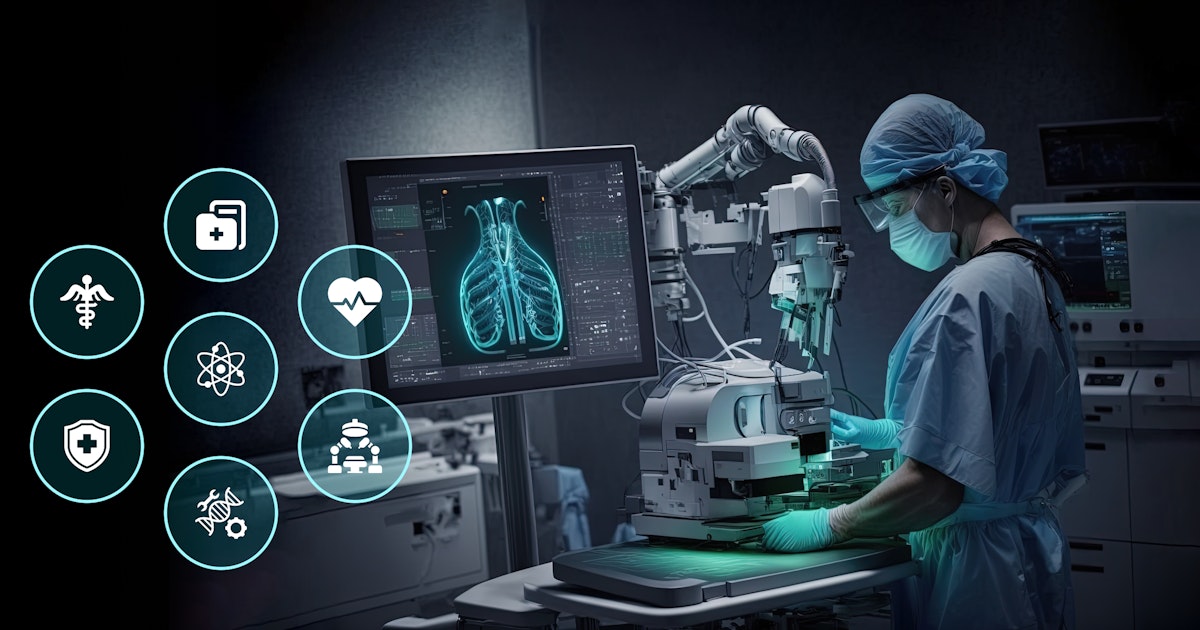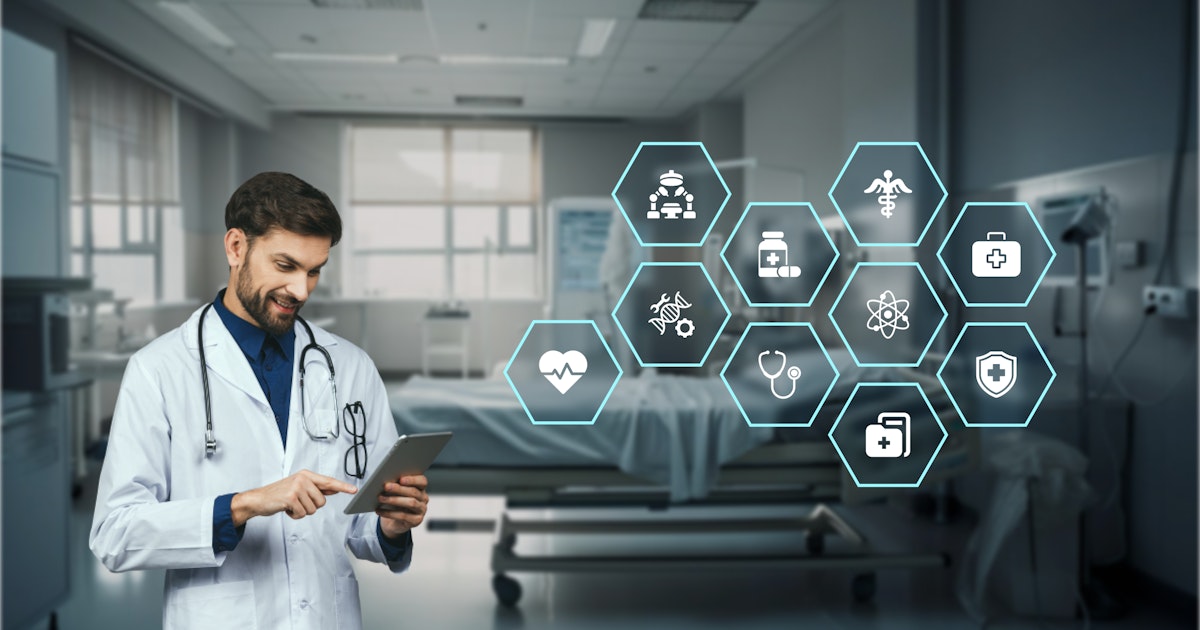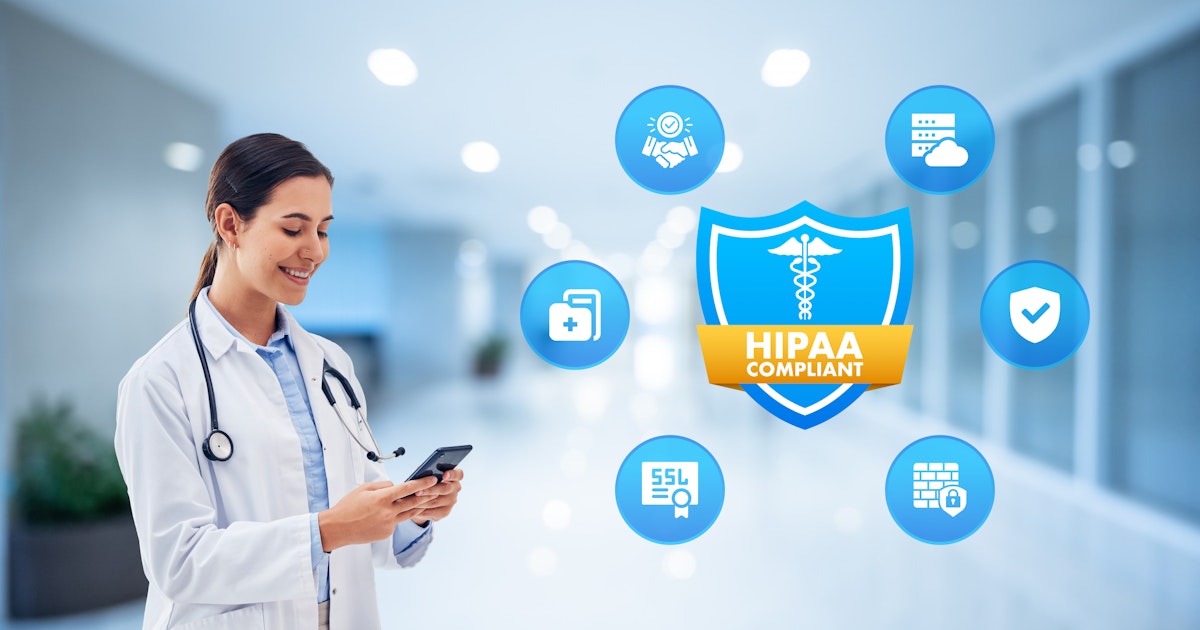Table of Content
Many types of health problems are on the rise, which are straining healthcare systems across the globe — a situation further magnified during the COVID-19 pandemic. Therefore, it is not a surprise to see healthcare organizations forcefully adopting innovative methods to offer uninterrupted services to patients even amidst the health crisis.
IoT within healthcare continues to proliferate in response to the increasing demand for healthcare services. One of the biggest growth areas of IoT implementation is Remote Patient Monitoring, or RPM, which has enabled at-risk patients to receive the care they deserve while remaining safe in their own homes.
RPM applications are medical devices that send data from sensors attached to patients and their environment to their healthcare providers for diagnosis and treatment monitoring purposes. Research shows that 90% of healthcare organizations and 50% of patients are interested in adopting remote patient monitoring systems as a part of their treatment process.
What is IoT-based remote patient monitoring?
IoT-based remote patient monitoring is a healthcare approach that uses Internet of Things (IoT) technology to collect and transmit patient health data from their home or other non-clinical settings to healthcare providers.
This allows for continuous monitoring of patient's vital signs and other health metrics without requiring them to be physically present in a medical facility.
Key aspects of IoT-based remote patient monitoring include:
- Sensors and wearable devices: Patients use various IoT-enabled devices like smartwatches, blood pressure monitors, glucose meters, or specialized wearables to collect health data.
- Data transmission: The collected data is securely transmitted over the internet to healthcare providers or a centralized system.
- Real-time monitoring: Healthcare professionals can access and analyze patient data in real-time, allowing for quick interventions if necessary.
- Alerts and notifications: The system can be programmed to send alerts to healthcare providers if a patient's vital signs fall outside normal ranges.
- Data analysis: Advanced analytics and AI can be applied to the collected data to identify trends or predict potential health issues.
How do RPM systems work?
IoT-enabled connected devices allow tracking of patient health at home, and the reports are sent to the doctor in real time. It makes routine checkups easier without the need for physical trips to the hospital, especially when it is far away.
An IoT-enabled healthcare system can also help improve access to medical facilities in remote areas where trained doctors and healthcare providers are not readily available.
RPM also proved helpful for patients with chronic conditions during the pandemic as it was not safe for them to visit the doctor in person. Collectively, we could save tens of billions every year if IoT is used in the healthcare industry.
The National Broadband Plan drafted by the Federal Communications Commission (FCC) predicts that using RPM technologies alongside electronic health records (EHR) could lead to a reduction of $700 billion over the next two decades.
Empower Your Healthcare Practice with IoT-Enabled Remote Monitoring!
Explore SolutionsImportance of IoT-based remote patient monitoring
RPM improves healthcare by making it more accessible and improving the quality of care. It offers several benefits, including reduced operating costs and expense of care. Deploying IoT technology also helps increase the revenue for hospitals, insurers, and patients. Some of the critical advantages are as follows:
1. Enhanced accessibility
RPM solutions offer more convenience to both patients and healthcare professionals. Patients do not need to miss their routine checkups due to doctor unavailability, nor do they have to rush in case of an emergency.
On the other hand, healthcare workers can perform efficiently, as the system allows for better coordination between caregivers. It also helps improve patient outcomes with nearly instant communication capabilities.
Virtual meetings can be easily scheduled, reducing the need for in-person appointments, whereas doctors can still have a face-to-face interaction with each patient.
2. Reduced response time
IoT-enabled RPM systems allow healthcare professionals to cater to their patients much more quickly than traditional methods. Earlier intervention is a crucial factor that helps physicians address serious medical events quicker and with greater accuracy.
They can instantly decide the medication to be administered as they continuously monitor patient vitals. The quicker response times help save lives by preventing delayed diagnoses.
Well-connected health devices help diagnose less severe conditions too. They are useful as treatments may be initiated faster with greater efficiency. And who does not want to receive medical care quickly and without any hassle?
3. Increased precision and accuracy
RPM devices provide enough information to bring together healthcare professionals, caretakers, patients, and even subject matter experts. They can accurately assess the patient's condition through the precise information generated by IoT devices.
It helps in medication management and titration to ensure appropriate dosages and safer adjustments. The capability of RPM systems can be enhanced by equipping them with GPS location detectors to help in case of an emergency.
It is beneficial for monitoring patients who have dementia or Alzheimer's because they may wander off from time to time. Caretakers can keep track of the patient and avoid chances of them going missing.
How IoMT Is Set To Transform The Medical And Healthcare Industry
Learn More4. Minimal admin paperwork
The benefits associated with using an accurate and precise IoT-enabled medical device are much more than just improving efficiency. The RPM system can also be used to furnish accurate information to insurers and government agencies so that they process claims more quickly.
Automation can help share patient data with the authorities to eliminate the need to fill out lengthy claim forms. The auto-generated reports from the RPM system and doctor prescriptions are securely transmitted to the concerned insurer or government office.
RPM devices help provide a better experience overall by accelerating the claim approval process based on the insurance company's policies.
5. Better safety and security
Security and patient data confidentiality are paramount in healthcare. Medical data must be kept secure, as the information is extremely sensitive. Maintaining data security when being collected, handled, transferred, and read is essential.
The data transmission happens on a highly secure IoT network. Smaller hospitals can even use RPM integration to upgrade their in-house data protection efforts.
It helps them easily comply with EMR (electronic medical record) regulations while meeting HIPAA (Health Insurance Portability and Accountability Act, 1996) requirements.
Application of IoT in remote patient monitoring
1. Improved glycemic control and personalized care for diabetics
Chronic disease management IoT devices play a crucial role in helping patients with chronic conditions like diabetes, hypertension, or heart disease monitor their health at home.
Continuous glucose monitors for diabetics transmit real-time blood sugar levels to healthcare providers, allowing for timely interventions and personalized treatment adjustments.
This approach has shown significant benefits, with one study finding that remote monitoring reduced HbA1c levels in diabetics by an average of 0.5% over 6 months. It indicates better long-term blood sugar control.
2. Reduced hospital readmissions through faster recovery
Post-surgery remote monitoring enables patients to be closely observed after discharge, reducing hospital stays and readmission rates. For instance, wearable patches that track vital signs and wound healing progress allow healthcare providers to detect complications early.
This technology has demonstrated impressive results, showing a substantial reduction in hospital readmissions for certain conditions. Ultimately leading to improved patient outcomes and reduced healthcare costs.
3. Enhanced treatment efficacy through better medication compliance
IoT-enabled pill bottles or dispensers can track and remind patients to take their medications, addressing a major challenge in healthcare. Smart pill bottles send alerts to patients and caregivers when doses are missed, improving treatment efficacy.
Research shows that IoT-based medication reminders can improve adherence rates by up to 30%, potentially leading to better health outcomes and reduced complications from chronic conditions.
4. Fall detection for elder patients living independently
IoT-enabled emergency response systems provide seniors living independently with a safety net. For example, a senior wearing a fall-detection sensor can automatically alert emergency services if a fall occurs.
Additionally, smart home devices can monitor daily activities and detect unusual patterns, prompting caregivers or family members to check-in. These systems ensure that seniors receive immediate assistance during emergencies. That will enhance their safety and peace of mind while allowing them to maintain their independence.
5. Early intervention in mental health disorders
IoT devices like smartwatches and mental health apps enable early intervention in mental health disorders. A person experiencing anxiety can use a smartwatch that tracks physiological signs such as heart rate and sleep patterns.
Data collected is analyzed to detect deviations from the norm, signaling potential issues. Mental health professionals can monitor this data remotely, providing timely interventions and personalized therapy adjustments.
This proactive approach helps manage symptoms more effectively and supports better mental health outcomes.
6. Better sleep quality and reduced health risks for apnea patients
IoT solutions like smart sleep apnea monitors help improve sleep quality and reduce health risks for apnea patients.
For instance, a patient can use a connected CPAP machine that adjusts airflow based on real-time monitoring of breathing patterns. Data collected is shared with healthcare providers, who can make necessary adjustments to the treatment.
This continuous monitoring ensures effective management of sleep apnea, reducing associated risks like cardiovascular issues and significantly enhancing the patient’s overall well-being.
7. Earlier detection of cardiac issues
IoT-enabled cardiac monitors facilitate the earlier detection of cardiac issues, ensuring timely treatment. A patient at risk of heart disease can wear a smart ECG monitor that tracks heart rhythms and transmits data to their cardiologist.
Any abnormal patterns trigger immediate alerts, it will allowing for rapid medical intervention. This real-time monitoring system helps in diagnosing issues before they escalate, providing an opportunity for timely treatment and significantly improving patient outcomes.
8. Reduced asthma attacks and improved quality of life for patients
IoT devices such as smart inhalers and air quality monitors help reduce asthma attacks and improve patients' quality of life. An asthma patient can use a smart inhaler that tracks medication usage and sends reminders for missed doses.
Additionally, connected air quality monitors can alert the patient to avoid environments with high pollution levels. These devices provide valuable data that help patients manage their condition proactively, reduce the frequency of attacks, and maintain a higher quality of life.
Best IoT devices for remote patient monitoring
Embracing RPM has improved patient safety and security of the data related to their health. It helps improve physical security with better fall prevention tools and digitally safeguards the patient's health information.
1. Smart blood pressure monitors
These devices offer accurate, easy-to-use blood pressure monitoring at home. Many can sync data directly to smartphones and healthcare provider systems. Blood pressure cuffs help monitor blood pressure. They are helpful for hypertension management, as most patients experiencing high blood pressure are asymptomatic.
2. Continuous glucose monitors (CGMs)
Essential for diabetics, CGMs provide real-time blood sugar readings without finger pricks. They offer invaluable insights into glucose trends, helping patients and doctors make informed decisions about insulin dosing and lifestyle changes.
Glucometers test the blood sugar level of type 1 and type 2 diabetes patients using a small drop of blood.
It is crucial to monitor blood sugar levels as the patient may not show any symptoms but might be suffering from hyperglycemia (too high glucose level) or hypoglycemia (too low glucose level). Digital glucometers help avoid the life-threatening condition of ketoacidosis.
3. Smart ECG/EKG monitors
Portable ECG devices allow patients to record their heart rhythm anytime, anywhere. ECG and digital stethoscopes are used for patients with arrhythmias or coronary artery disease. Some can detect atrial fibrillation and other arrhythmias, providing early warning for potential cardiac issues.
4. Smart scales with body composition analysis
These scales go beyond weight, measuring metrics like body fat percentage, muscle mass, and bone density. They're particularly useful for monitoring patients with conditions affected by weight and body composition changes.
Weight monitors come in handy for measuring fluctuations in weight. It helps avoid Congestive Heart Failure (CHF) due to fluid retention.
It is also valuable for obesity control as it helps monitor weight loss and alerts healthcare practitioners if rapid weight loss occurs in a patient. It can lead to complications such as weak bones, compromised immune systems, fatigue, and dehydration.
5. Wearable activity trackers
Devices like Fitbit or Apple Watch offer comprehensive health monitoring, tracking steps, sleep patterns, heart rate, and even blood oxygen levels. They provide a holistic view of a patient's daily health and activity levels.
6. Smart pill dispensers and trackers
These devices help patients stick to their medication regimens by providing reminders and tracking adherence. Some can even alert caregivers or healthcare providers if doses are missed.
7. Smart Inhalers for Asthma and COPD Patients
Spirometers are extremely useful for pulmonary function testing and diagnosing lung infections such as asthma and COPD. These devices attach to regular inhalers to track usage, measure inspiratory flow, and even provide environmental data to help predict and prevent attacks.
8. Sleep apnea monitors
These devices track breathing patterns, oxygen levels, and other sleep metrics to help diagnose and manage sleep apnea without the need for in-lab sleep studies. Pulse oximeters monitor blood oxygen levels for COPD (chronic obstructive pulmonary disease), CHF (congestive heart failure)
9. Fall detection devices
Particularly useful for elderly patients, these wearable devices can detect falls and automatically alert emergency services or caregivers.
Example of IoT devices for remote patient monitoring
1. Omron HeartGuide
This wearable blood pressure monitor looks like a smartwatch but can take clinical-grade blood pressure readings throughout the day.
2. Dexcom G6 continuous glucose monitoring system
A popular CGM for diabetics, the Dexcom G6 uses a small sensor inserted under the skin to provide real-time glucose readings every 5 minutes.
3. AliveCor KardiaMobile
This pocket-sized ECG device can record medical-grade ECGs in just 30 seconds. Users place their fingers on the sensors, and the device can detect atrial fibrillation and other heart rhythm abnormalities.
4. Withings body cardio
Scale More than just a scale, this device measures weight, body composition, heart rate, and even pulse wave velocity (a measure of arterial stiffness). All data syncs automatically to a smartphone app.
5. Apple watch series 8
While primarily a smartwatch, it offers features like ECG, blood oxygen monitoring, fall detection, and activity tracking, making it a comprehensive health monitoring tool.
6. Hero medication dispenser
This smart device can store and dispense up to a 90-day supply of 10 different medications. It provides audible and visual reminders and can notify caregivers if doses are missed.
7. TytoCare tytohome medical exam kit
This all-in-one kit includes devices to examine the heart, lungs, ears, skin, throat, and measure body temperature. It allows for remote medical exams guided by healthcare providers.
8. Propeller health sensor
This small device attaches to asthma or COPD inhalers to track usage, remind patients to use their preventive medications, and even provide local air quality data.
9. ResMed AirSense 11
AutoSet A smart CPAP machine for sleep apnea that automatically adjusts air pressure and tracks sleep data. It can transmit this data to healthcare providers for remote monitoring.
10. Philips GoSafe 2 medical alert system
This wearable device offers fall detection, GPS location tracking, and two-way communication for seniors. It can automatically alert emergency services if a fall is detected.
11. Qardio arm smart blood pressure monitor
A wireless blood pressure monitor that's clinically validated and can sync data with smartphones. It can be set up for multiple users, making it ideal for families.
Best practices for designers and developers of RPM
1. Have a plan of action
IoT vendors must provide fit-for-purpose security in their healthcare products and services. They must lay out a risk management process and determine security objectives while designing the RPM products.
2. Segment the network for security reasons
Network segmentation must be implemented as a security measure that protects networks by creating different subnets for each network segment. This allows administrators to control traffic flowing through the entire hospital's internet connection and set rules for each of them.
3. Use AI-driven security solutions
Such apps can identify threats that would otherwise go unnoticed by traditional firewalls and antivirus software. They track non-typical activity and changes in user behavior and are better equipped to avoid potential security breaches.
4. Deploy IoT aggregation hubs
The IoT ecosystem is already vulnerable due to the amount of data involved. That is why please keep an eye on all devices connected to the network and control their traffic settings. Deploying IoT aggregation hubs protects the devices from being hacked by third parties who want to attack these crucial systems.
5. Use inventory software for detecting malfunctioning
Monitor the devices on the IoT network using any inventory software that will help detect any malfunctioning. It will also ease remote monitoring and maintenance along with diagnosing security issues. Maintenance can also be scheduled to minimize downtime in a clinical setting.
An All-Inclusive Guide On The Top IoT Sensors In The Market
Learn More6. Make device ports difficult to access
Medical devices are vulnerable to hacking, and much damage can be caused just by installing a malicious chip into the system. Companies must make their device ports challenging to access and seal them with electronic digital signatures.
7. Monitor device activity in real-time
This is a vital practice for developers to follow to help detect suspicious signals or code from hackers attempting to compromise the IoT network security perimeter.
8. Build a protective shield around RPM products
The increase in electronic devices generates more EMI (electromagnetic interference issue), leading to problems in the operation of the RPM products.
The products may generate interference with each other or any nearby electronics that receive their signals. A shield should be built up around each device to protect against outside threats such as microwaves and radio waves crashing into its sensitive parts to avoid this issue.
9. Protect the IoT data with encryption
Embedded devices currently use asymmetric lightweight cryptography (LWCRYPT) techniques. IoT-enabled wearable sensors must contain keys for establishing protected data transfer channels among the devices and the end-users.
Bespoke Healthcare Software Solutions
Get In Touch10. Implement an authentication procedure to safeguard data
Complex authentication will not allow anyone from within the organization to access the information without permission. The best thing would also include strict policies about who can access the data at a particular time and under what circumstances.
It eliminates possible vulnerabilities, and the elaborate security measures protect against hackers attacking patient records.
Future of IoT-enabled remote patient monitoring with AI integration
The future of IoT-based remote patient monitoring stands poised to revolutionize healthcare delivery. From AI-driven predictive analytics to advanced wearables and implantable sensors, these innovations promise to bridge the gap between patients and healthcare providers like never before.
AI-Powered predictive analytics
Future IoT devices will leverage artificial intelligence to predict health events before they occur. By analyzing patterns in vital signs, activity levels, and other health data, these systems could forecast potential health issues days or even weeks in advance, allowing for preventive interventions.
Advanced wearables
Next-generation wearables will go beyond current capabilities, potentially offering features like continuous, non-invasive blood glucose monitoring, real-time tracking of multiple biomarkers, and more accurate heart health monitoring. These devices will provide a more comprehensive and nuanced view of a patient's health status.
Implantable sensors
Miniaturization of technology will lead to more sophisticated implantable sensors. These could continuously monitor internal body functions, from blood chemistry to organ performance, providing a deeper understanding of a patient's health status without the need for invasive procedures or frequent hospital visits.
Personalized medicine delivery systems
Smart drug delivery systems could adjust medication dosages in real time based on continuous monitoring of a patient's physiological state. This could optimize treatment efficacy, minimize side effects, and improve patient outcomes, especially for chronic conditions requiring constant management.
Holographic telemedicine
Remote consultations could evolve to include 3D holographic projections, allowing doctors to perform virtual physical examinations with a level of detail and interaction close to in-person visits. This technology could significantly improve the quality of remote healthcare, especially for patients in rural or underserved areas.
Environmental health monitoring
IoT devices will increasingly factor in environmental data, correlating factors like air quality, pollen counts, and UV levels with individual health metrics. This comprehensive approach will provide a more complete view of health influences, enabling more effective personalized health management strategies.
These advancements represent the cutting edge of IoT in healthcare, promising to make remote patient monitoring more accurate, predictive, and personalized than ever before.
Ready to Implement IoT in Your Remote Healthcare Current Practices?
Let's TalkOver to you
Remote patient monitoring is an incredible opportunity in the healthcare industry. It promises to revolutionize healthcare by reaching $3,244.9 million by 2027.
An increasing number of patients with chronic diseases and rising awareness about early intervention are the reasons for RPM's estimated CAGR of 18.9% from 2020 to 2027.
Besides the exponential growth in remote patient monitoring devices, the global market anticipates restructuring doctor-patient relationships. The use of IoT technology will remove the need for face-to-face encounters between doctors and their clients.
IoT technology is beneficial for patients residing in remote areas with limited availability of doctors. Healthcare professionals would also not be overworked and constant monitoring of patients would be comfortable.
They will have enough patient information in real time to make informed treatment decisions. If you are looking to create an IoT-powered application for remote patient monitoring purposes, get in touch with our expert today!




